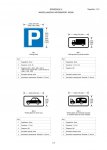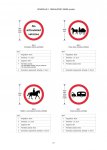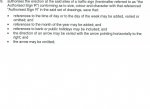Back on Topic again.
The TSRGD prescribes the designs and conditions of use for traffic signs, (which includes road markings, traffic signals and pedestrian crossings), to be lawfully placed on or near roads in England, Scotland and Wales, with a limited number prescribed for use only in England or in Scotland.
The TSRGD contains all the signs that are
prescribed to be erected on the highway. Local Authorities can also apply to the Secretary of State for
approval of a sign that is not currently in the TSRGD. Only these signs can be displayed on the highway. The highway includes a band up to the building line or fence line or 15 yards from the road in the case of common land. Unofficial signs are therefor unlawful.
The TSRO contains a
prescribed sign that used together with a P sign to indicate parking place for caravans towed by cars and Motor caravans.

There is a
prescribed prohibition sign prohibiting the parking of caravans towed by a motor vehicle.

There is a no waiting sign (Approved sign R) that has been
approved for use in England. This sign is to prohibit the waiting for motor caravans, between certain hours.


Please note the words that are permitted, anything else is not. This sign is not approved for use in Wales or Scotland. This has been determined by use of FOI requests. Northern Ireland has its own regulations. Any new signs not conforming to this are therefor unlawful.
Motorhomes are strange beasts, not quite fitting into the law as it relates to cars.
Try finding anything to do with motorhomes in the Highway Code and you’ll be disappointed. But they are still road vehicles,
Responsible motor caravanners' will want to obey the law but it is sometimes hard to find out just what those laws are – and you may be surprised to learn that it can often be just as difficult for the enforcement authorities.
Legally, motorhomes do not quite fit into the law on cars, nor those on heavier vehicles, but lie somewhere in between. So what is a ‘Motorhome’? or ‘motor caravan’, or ‘living van’, ‘leisure vehicle’, or ’campervan’ for that matter? There is not even one agreed description in English for it!
They are defined under Directive 2002/24/EC as Special purpose, Motor vehicles with at least four wheels: Category M: used for the carriage of passengers
5. "Special purpose vehicle" means a vehicle of category M, N or O for conveying passengers or goods and for performing a special function for which special body arrangements and/or equipment are necessary.
5.1. "Motor caravan" means a special purpose M category vehicle constructed to include living accommodation which contains at least the following equipment:
- seats and table,
- sleeping accommodation which may be converted from the seats,
- cooking facilities, and
- storage facilities.
This equipment shall be rigidly fixed to the living compartment; however, the table may be designed to be easily removable.
So we have a situation where a Motorhome is a vehicle defined under the 1984/88 Road Traffic Act as a "motor car" if it weighs under 3050kg unladen or a "heavy motor car" of over that weight. However speed limits are defined for vehicle above or below 3500kg laden. Confusing! Speed limits relate to un-laden weight not laden.
The Department for Transport (DfT) vehicle stats, do not know either. When asked about the number of motorhomes registered in the UK I received the following data
Licenced 2014
March
Category 2014 q1
Missing 166,170
M1 10,464
N1 17,515
N2 1,884
Other 37,749
Total 233,782
SORN 37,634
Total 271,416
M! are passenger vehicles N1 and N2 are goods vehicles. Yet "Directive 2002/24/EC" specifies Motorhomes as
Special Purpose, Motor vehicles with at least four wheels: Category M: used for the carriage of passengers. So what are "Missing" and "Other". They are obviously taxed, MOTd and Insured to be licenced. I have not used the individual figures for SORN.
Reading the vehicle categories there is no provision for Special Purpose, passenger carrying, goods vehicles.
Caravan sites are not what they were when set up under The Caravan Sites and Control of Development Act 1960. This Act was amended in 1968 to accommodate units, larger than those that could be legally towed on the road and twin units. Sites have increasing been turned into parks for Static Residential and Holiday Units and increasingly now lodges. Their initial function as places for touring has been lost. However local authorities licence them as caravan sites. Many local authority official do not understand, or refuse to accept, that there is a difference. Some seem to think they are car parks for Motorhomes that you can just drop into or leave as you wish using the dump facilities on site with no need to book. Again this had become apparent from FOI requests.
Laws have been passed to regulate the Residential Parks and in Wales a move is afoot to do the same for Holiday Static Parks. However all if these new regulations define the unit as a caravan using most of the definition of a caravan in the 1960 Act.
The Highways Agency has issued a new circular defining the activities that can take place on Motorway Service Areas. This replaces the 2008 circular. The 2013 circular has removed the whole section from the 2008 on concerning motorhomes pars 81 to 84. This provided the possibility of MSA providing drinking water and waste (black and grey) water disposal facilities on MSAs. Again motorhome users have been disregarded by those drafting UK regulations.
Unless we make our presence felt we will lose more and more facilities.
Northern Ireland has an approved sign for motorhome facilities. This has been recommended for inclusion in the 2015 TSRGD

This sign at present is not approved for use in the rest of the UK. Northern Ireland and the Republic now have Aire similar to the rest of Europe. The UK has no Aires with services only a few stopover locations, such as Hawick and Torridge.





